MAZDA MODEL 5 2010 Workshop Manual
Manufacturer: MAZDA, Model Year: 2010, Model line: MODEL 5, Model: MAZDA MODEL 5 2010Pages: 392, PDF Size: 4.81 MB
Page 51 of 392
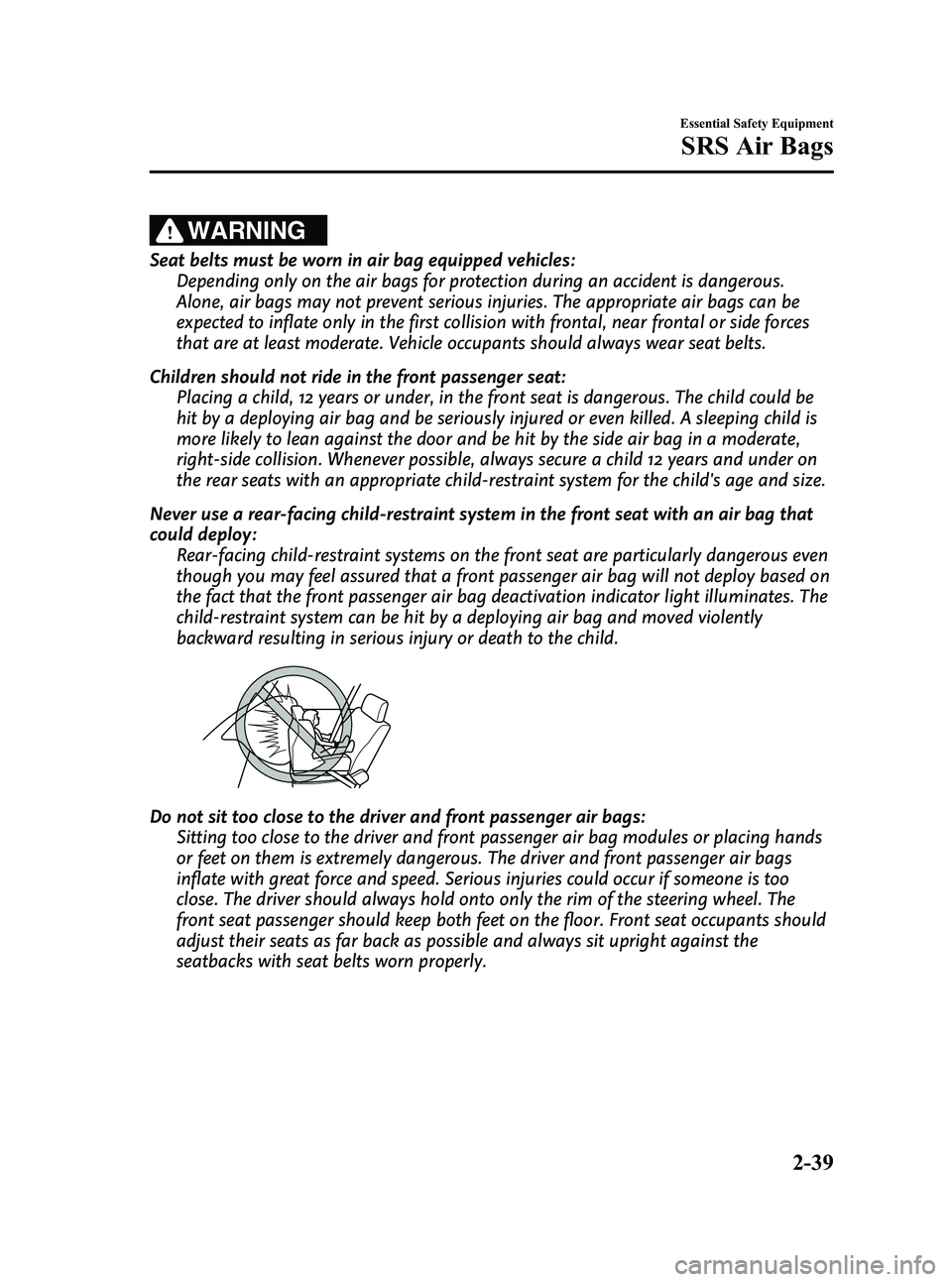
Black plate (51,1)
WARNING
Seat belts must be worn in air bag equipped vehicles:Depending only on the air bags for protection during an accident is dangerous.
Alone, air bags may not prevent serious injuries. The appropriate air bags can be
expected to inflate only in the first collision with frontal, near frontal or side forces
that are at least moderate. Vehicle occupants should always wear seat belts.
Children should not ride in the front passenger seat: Placing a child, 12 years or under, in the front seat is dangerous. The child could be
hit by a deploying air bag and be seriously injured or even killed. A sleeping child is
more likely to lean against the door and be hit by the side air bag in a moderate,
right-side collision. Whenever possible, always secure a child 12 years and under on
the rear seats with an appropriate child-restraint system for the child's age and size.
Never use a rear-facing child-restraint system in the front seat with an air bag that
could deploy: Rear-facing child-restraint systems on the front seat are particularly dangerous even
though you may feel assured that a front passenger air bag will not deploy based on
the fact that the front passenger air bag deactivation indicator light illuminates. The
child-restraint system can be hit by a deploying air bag and moved violently
backward resulting in serious injury or death to the child.
Do not sit too close to the driver and front passenger air bags:Sitting too close to the driver and front passenger air bag modules or placing hands
or feet on them is extremely dangerous. The driver and front passenger air bags
inflate with great force and speed. Serious injuries could occur if someone is too
close. The driver should always hold onto only the rim of the steering wheel. The
front seat passenger should keep both feet on the floor. Front seat occupants should
adjust their seats as far back as possible and always sit upright against the
seatbacks with seat belts worn properly.
Essential Safety Equipment
SRS Air Bags
2-39
Mazda5_8AU7-EA-09H_Edition4 Page51
Tuesday, March 30 2010 1:9 PM
Form No.8AU7-EA-09H
Page 52 of 392
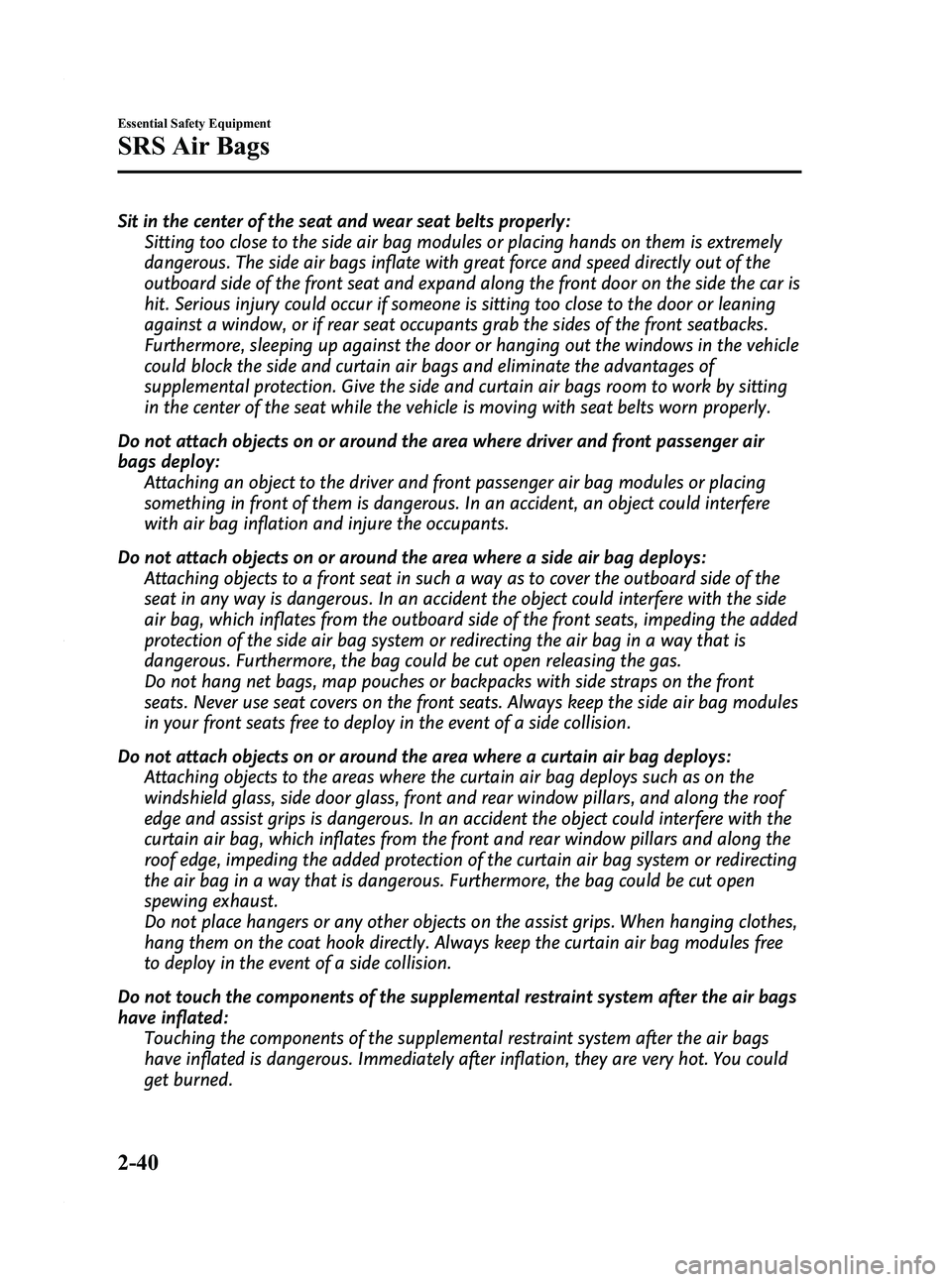
Black plate (52,1)
Sit in the center of the seat and wear seat belts properly:Sitting too close to the side air bag modules or placing hands on them is extremely
dangerous. The side air bags inflate with great force and speed directly out of the
outboard side of the front seat and expand along the front door on the side the car is
hit. Serious injury could occur if someone is sitting too close to the door or leaning
against a window, or if rear seat occupants grab the sides of the front seatbacks.
Furthermore, sleeping up against the door or hanging out the windows in the vehicle
could block the side and curtain air bags and eliminate the advantages of
supplemental protection. Give the side and curtain air bags room to work by sitting
in the center of the seat while the vehicle is moving with seat belts worn properly.
Do not attach objects on or around the area where driver and front passenger air
bags deploy: Attaching an object to the driver and front passenger air bag modules or placing
something in front of them is dangerous. In an accident, an object could interfere
with air bag inflation and injure the occupants.
Do not attach objects on or around the area where a side air bag deploys: Attaching objects to a front seat in such a way as to cover the outboard side of the
seat in any way is dangerous. In an accident the object could interfere with the side
air bag, which inflates from the outboard side of the front seats, impeding the added
protection of the side air bag system or redirecting the air bag in a way that is
dangerous. Furthermore, the bag could be cut open releasing the gas.
Do not hang net bags, map pouches or backpacks with side straps on the front
seats. Never use seat covers on the front seats. Always keep the side air bag modules
in your front seats free to deploy in the event of a side collision.
Do not attach objects on or around the area where a curtain air bag deploys: Attaching objects to the areas where the curtain air bag deploys such as on the
windshield glass, side door glass, front and rear window pillars, and along the roof
edge and assist grips is dangerous. In an accident the object could interfere with the
curtain air bag, which inflates from the front and rear window pillars and along the
roof edge, impeding the added protection of the curtain air bag system or redirecting
the air bag in a way that is dangerous. Furthermore, the bag could be cut open
spewing exhaust.
Do not place hangers or any other objects on the assist grips. When hanging clothes,
hang them on the coat hook directly. Always keep the curtain air bag modules free
to deploy in the event of a side collision.
Do not touch the components of the supplemental restraint system after the air bags
have inflated: Touching the components of the supplemental restraint system after the air bags
have inflated is dangerous. Immediately after inflation, they are very hot. You could
get burned.
2-40
Essential Safety Equipment
SRS Air Bags
Mazda5_8AU7-EA-09H_Edition4 Page52
Tuesday, March 30 2010 1:9 PM
Form No.8AU7-EA-09H
Page 53 of 392
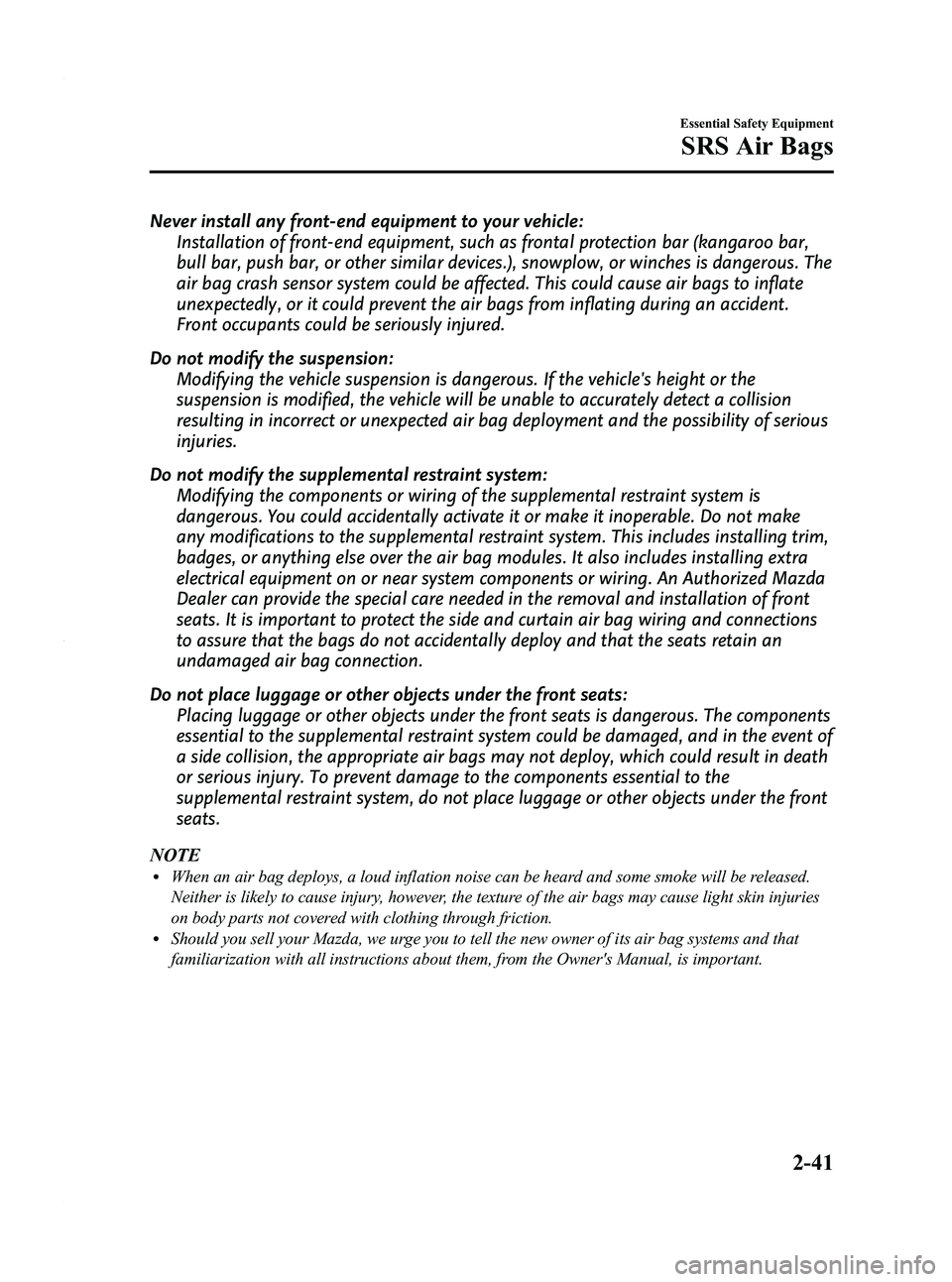
Black plate (53,1)
Never install any front-end equipment to your vehicle:Installation of front-end equipment, such as frontal protection bar (kangaroo bar,
bull bar, push bar, or other similar devices.), snowplow, or winches is dangerous. The
air bag crash sensor system could be affected. This could cause air bags to inflate
unexpectedly, or it could prevent the air bags from inflating during an accident.
Front occupants could be seriously injured.
Do not modify the suspension: Modifying the vehicle suspension is dangerous. If the vehicle's height or the
suspension is modified, the vehicle will be unable to accurately detect a collision
resulting in incorrect or unexpected air bag deployment and the possibility of serious
injuries.
Do not modify the supplemental restraint system: Modifying the components or wiring of the supplemental restraint system is
dangerous. You could accidentally activate it or make it inoperable. Do not make
any modifications to the supplemental restraint system. This includes installing trim,
badges, or anything else over the air bag modules. It also includes installing extra
electrical equipment on or near system components or wiring. An Authorized Mazda
Dealer can provide the special care needed in the removal and installation of front
seats. It is important to protect the side and curtain air bag wiring and connections
to assure that the bags do not accidentally deploy and that the seats retain an
undamaged air bag connection.
Do not place luggage or other objects under the front seats: Placing luggage or other objects under the front seats is dangerous. The components
essential to the supplemental restraint system could be damaged, and in the event of
a side collision, the appropriate air bags may not deploy, which could result in death
or serious injury. To prevent damage to the components essential to the
supplemental restraint system, do not place luggage or other objects under the front
seats.
NOTE
lWhen an air bag deploys, a loud inflation noise can be heard and some smoke will be released.
Neither is likely to cause injury, however, the texture of the air bags may cause light skin injuries
on body parts not covered with clothing through friction.
lShould you sell your Mazda, we urge you to tell the new owner of its air bag systems and that
familiarization with all instructions about them, from the Owner's Manual, is important.
Essential Safety Equipment
SRS Air Bags
2-41
Mazda5_8AU7-EA-09H_Edition4 Page53
Tuesday, March 30 2010 1:9 PM
Form No.8AU7-EA-09H
Page 54 of 392

Black plate (54,1)
Supplemental Restraint System Components
The supplemental restraint systems (SRS) have two basic subsystems:lThe air bag system with inflators and air bags.lThe electrical system with crash sensors and diagnostic module.
The air bags are mounted in the following locations:
lThe steering wheel hublThe front passenger dashboardlThe outboard sides of the front seatbackslThe front and rear window pillars, and the roof edge along both sides
The air bags are out of sight until activated.
Driver/Front passenger inflators and air bags
Crash sensors, and diagnostic module (SAS unit)
Front seat belt pretensioners (page 2-20)
Front air bag sensor
Side crash sensors
Air bag/front seat belt pretensioner system warning light
Side and curtain inflators and air bags
Front passenger air bag deactivation indicator light (page 2-44)
Front passenger seat weight sensors (page 2-44)
Front passenger seat weight sensor control module
2-42
Essential Safety Equipment
SRS Air Bags
Mazda5_8AU7-EA-09H_Edition4 Page54
Tuesday, March 30 2010 1:9 PM
Form No.8AU7-EA-09H
Page 55 of 392

Black plate (55,1)
Driver and front passenger seat belt buckle switches (page 2-44)
Driver seat slide position sensor
Front seats
Essential Safety Equipment
SRS Air Bags
2-43
Mazda5_8AU7-EA-09H_Edition4 Page55
Tuesday, March 30 2010 1:10 PM
Form No.8AU7-EA-09H
Page 56 of 392

Black plate (56,1)
How the Air Bags Work
qHow the Front Air Bags Work
When air bag crash sensors detect a frontal impact of greater than moderate force, an
electrical current is sent to the inflators.
Gases are produced to inflate the front air bags and after the inflation, the front air bags
quickly deflate.
The front air bags will function only once. After that, the front air bags will not work
again and must be replaced.
Only an Authorized Mazda Dealer can replace the system components.
The front, dual stage air bags control air bag inflation in two energy stages. During an
impact of moderate severity the front air bags deploy with lesser energy, whereas during
more severe impacts, they deploy with more energy. Deployment of the front air bags may
differ between the driver and the front passenger depending on the driver seat position,
front passenger weight and front seat belt usage, all of which provide data from each sensor
to the air bag system.
The front air bags will deploy only
in a frontal or frontal offset impact.
Driver seat slide position sensor
Your vehicle is equipped with a driver seat slide position sensor as a part of the
supplemental restraint system. The sensor is located under the driver seat. The sensor
determines whether the driver seat is fore or aft of a reference position and sends the seat
position to the diagnostic module (SAS unit). The SAS unit is also designed to control the
deployment of the driver air bag depending on how close the driver seat is to the steering
wheel.
The air bag/front seat belt pretensioner system warning light flashes if the sensor has a
possible malfunction (page 2-53).
2-44
Essential Safety Equipment
SRS Air Bags
Mazda5_8AU7-EA-09H_Edition4 Page56
Tuesday, March 30 2010 1:10 PM
Form No.8AU7-EA-09H
Page 57 of 392

Black plate (57,1)
Front passenger seat weight sensors
Your vehicle is equipped with a front passenger seat weight sensors as a part of the
supplemental restraint system. (page 2-33). These sensors are located under both of the
front passenger seat rails. These sensors determine the total seated weight on the front
passenger seat. The SAS unit is designed to prevent the front passenger front and side air
bags and seat belt pretensioner system from deploying if the total seated weight is less than
approximately 30 kg (66 lbs).
To reduce the chance of injuries caused by deployment of the front passenger air bag, the
system deactivates the front passenger front and side air bags and also the seat belt
pretensioner system when:
lThere is no passenger in the front passenger seat. (The front passenger air bag
deactivation indicator light does not illuminate.)
lThe total seated weight on the front passenger seat is less than approximately 30 kg (66
lbs). (The front passenger air bag deactivation indicator light illuminates.)
This system shuts off the front passenger front and side air bags and seat belt pretensioner
system, so make sure the front passenger air bag deactivation indicator light illuminates
according to the following table.
The air bag/front seat belt pretensioner system warning light flashes and the front
passenger air bag deactivation indicator light illuminates if the sensors have a possible
malfunction. If this happens, the front passenger front and side air bags and seat belt
pretensioner system will not deploy.
Front passenger air bag deactivation indicator light
This indicator light illuminates to remind you that the front passenger front and side air
bags and seat belt pretensioner will not deploy during a collision.
Essential Safety Equipment
SRS Air Bags
2-45
Mazda5_8AU7-EA-09H_Edition4 Page57
Tuesday, March 30 2010 1:10 PM
Form No.8AU7-EA-09H
Page 58 of 392
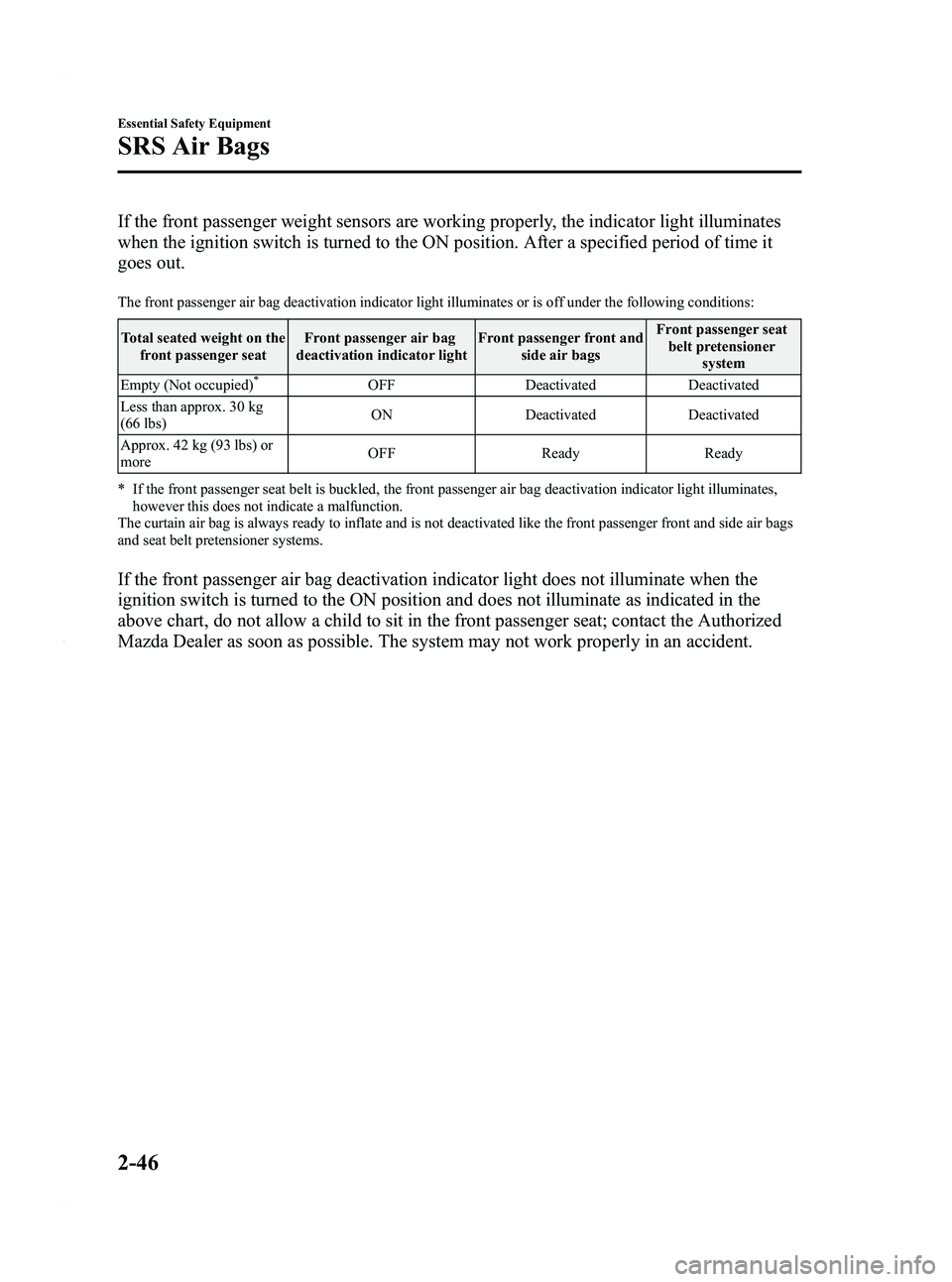
Black plate (58,1)
If the front passenger weight sensors are working properly, the indicator light illuminates
when the ignition switch is turned to the ON position. After a specified period of time it
goes out.
The front passenger air bag deactivation indicator light illuminates or is off under the following conditions:Total seated weight on the front passenger seat Front passenger air bag
deactivation indicator light Front passenger front and
side air bags Front passenger seat
belt pretensioner system
Empty (Not occupied)
*OFF Deactivated Deactivated
Less than approx. 30 kg
(66 lbs) ON
Deactivated Deactivated
Approx. 42 kg (93 lbs) or
more OFF
ReadyReady
* If the front passenger seat belt is buckled, the front passenger air bag deactivation indicator light illuminates, however this does not indicate a malfunction.
The curtain air bag is always ready to inflate and is not deactivated like the front passenger front and side air bags
and seat belt pretensioner systems.
If the front passenger air bag deactivation indicator light does not illuminate when the
ignition switch is turned to the ON position and does not illuminate as indicated in the
above chart, do not allow a child to sit in the front passenger seat; contact the Authorized
Mazda Dealer as soon as possible. The system may not work properly in an accident.
2-46
Essential Safety Equipment
SRS Air Bags
Mazda5_8AU7-EA-09H_Edition4 Page58
Tuesday, March 30 2010 1:10 PM
Form No.8AU7-EA-09H
Page 59 of 392
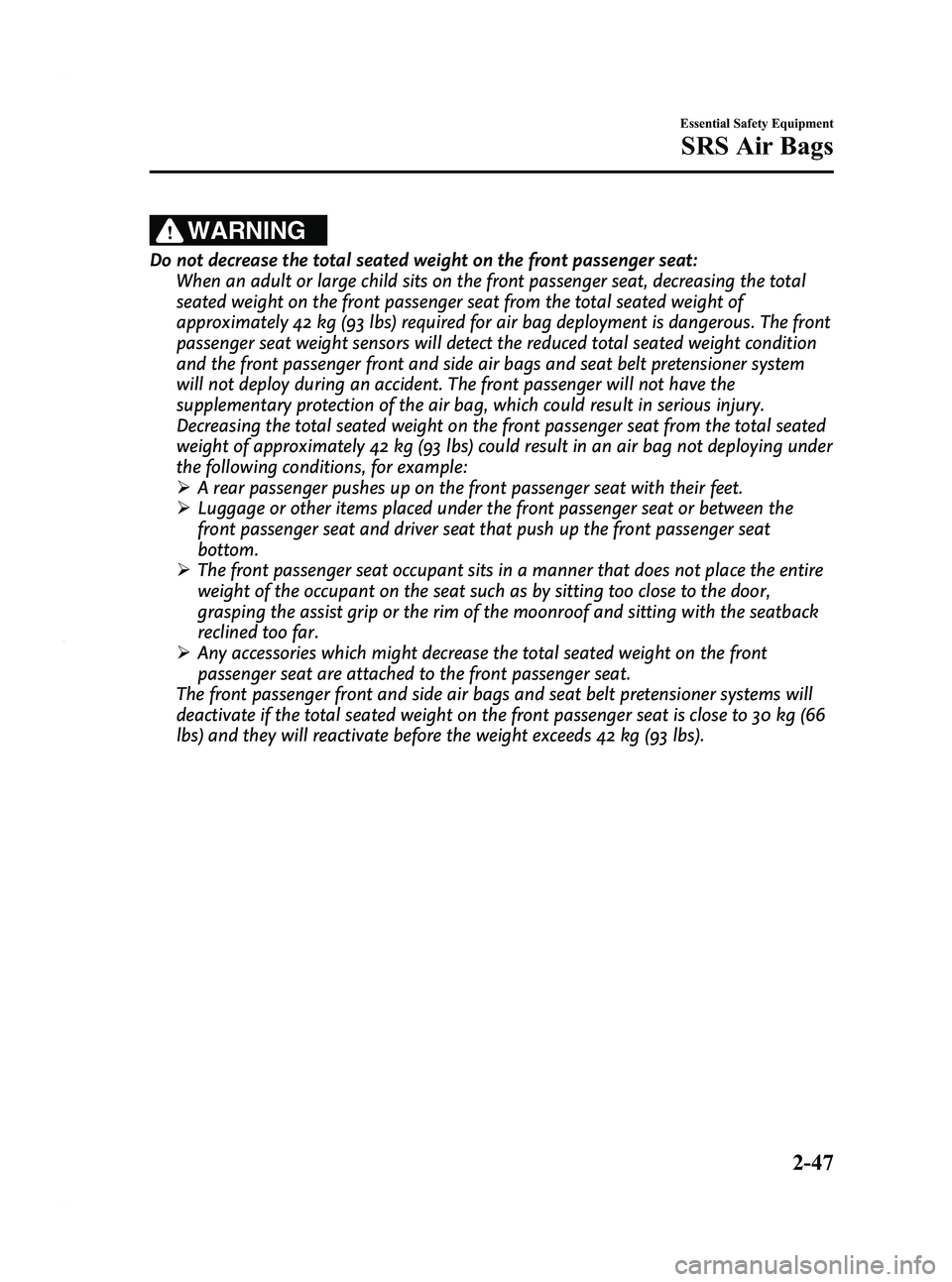
Black plate (59,1)
WARNING
Do not decrease the total seated weight on the front passenger seat:When an adult or large child sits on the front passenger seat, decreasing the total
seated weight on the front passenger seat from the total seated weight of
approximately 42 kg (93 lbs) required for air bag deployment is dangerous. The front
passenger seat weight sensors will detect the reduced total seated weight condition
and the front passenger front and side air bags and seat belt pretensioner system
will not deploy during an accident. The front passenger will not have the
supplementary protection of the air bag, which could result in serious injury.
Decreasing the total seated weight on the front passenger seat from the total seated
weight of approximately 42 kg (93 lbs) could result in an air bag not deploying under
the following conditions, for example:
ØA rear passenger pushes up on the front passenger seat with their feet.
Ø Luggage or other items placed under the front passenger seat or between the
front passenger seat and driver seat that push up the front passenger seat
bottom.
Ø The front passenger seat occupant sits in a manner that does not place the entire
weight of the occupant on the seat such as by sitting too close to the door,
grasping the assist grip or the rim of the moonroof and sitting with the seatback
reclined too far.
Ø Any accessories which might decrease the total seated weight on the front
passenger seat are attached to the front passenger seat.
The front passenger front and side air bags and seat belt pretensioner systems will
deactivate if the total seated weight on the front passenger seat is close to 30 kg (66
lbs) and they will reactivate before the weight exceeds 42 kg (93 lbs).
Essential Safety Equipment
SRS Air Bags
2-47
Mazda5_8AU7-EA-09H_Edition4 Page59
Tuesday, March 30 2010 1:10 PM
Form No.8AU7-EA-09H
Page 60 of 392
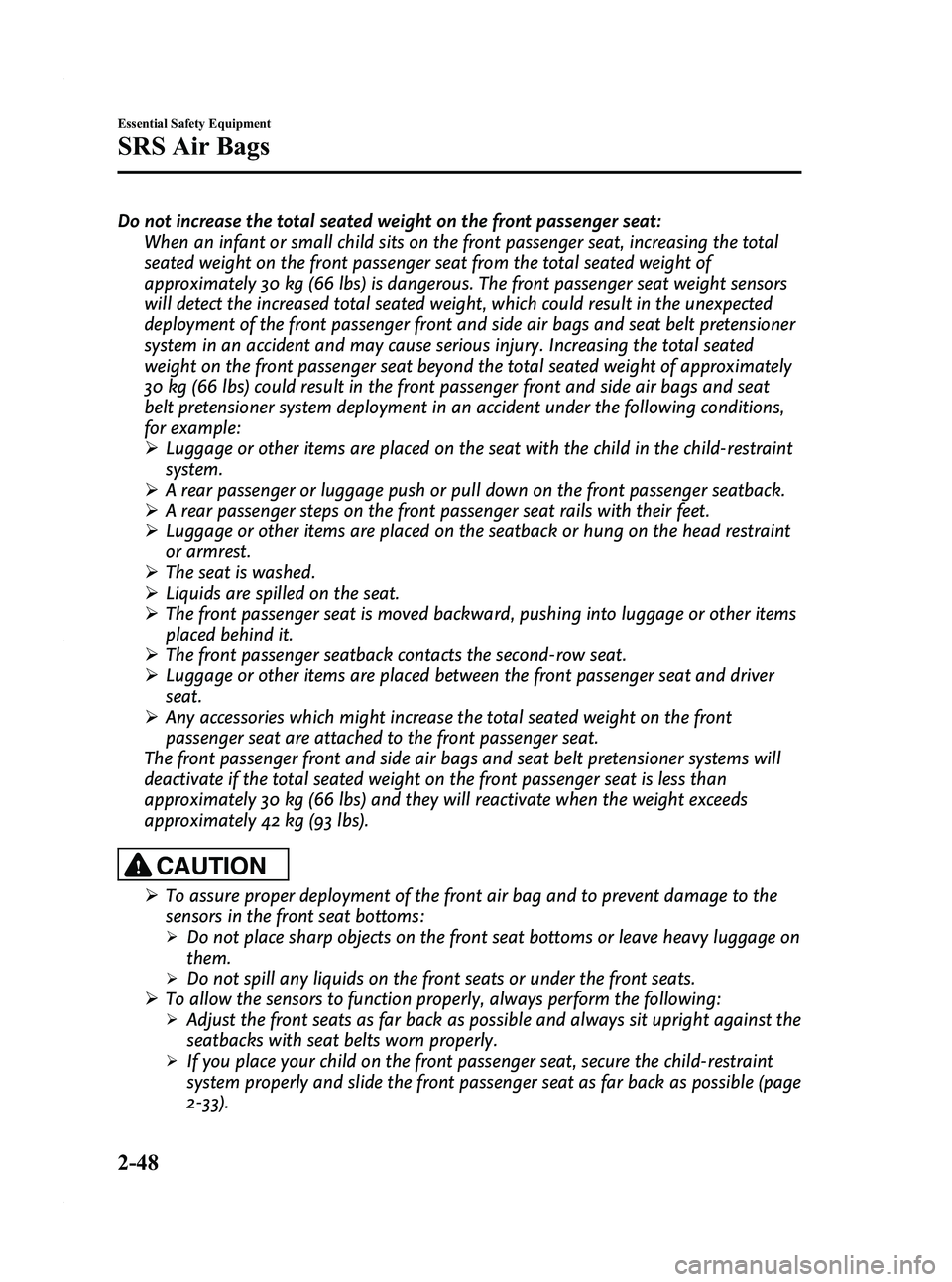
Black plate (60,1)
Do not increase the total seated weight on the front passenger seat:When an infant or small child sits on the front passenger seat, increasing the total
seated weight on the front passenger seat from the total seated weight of
approximately 30 kg (66 lbs) is dangerous. The front passenger seat weight sensors
will detect the increased total seated weight, which could result in the unexpected
deployment of the front passenger front and side air bags and seat belt pretensioner
system in an accident and may cause serious injury. Increasing the total seated
weight on the front passenger seat beyond the total seated weight of approximately
30 kg (66 lbs) could result in the front passenger front and side air bags and seat
belt pretensioner system deployment in an accident under the following conditions,
for example:
ØLuggage or other items are placed on the seat with the child in the child-restraint
system.
Ø A rear passenger or luggage push or pull down on the front passenger seatback.
Ø A rear passenger steps on the front passenger seat rails with their feet.
Ø Luggage or other items are placed on the seatback or hung on the head restraint
or armrest.
Ø The seat is washed.
Ø Liquids are spilled on the seat.
Ø The front passenger seat is moved backward, pushing into luggage or other items
placed behind it.
Ø The front passenger seatback contacts the second-row seat.
Ø Luggage or other items are placed between the front passenger seat and driver
seat.
Ø Any accessories which might increase the total seated weight on the front
passenger seat are attached to the front passenger seat.
The front passenger front and side air bags and seat belt pretensioner systems will
deactivate if the total seated weight on the front passenger seat is less than
approximately 30 kg (66 lbs) and they will reactivate when the weight exceeds
approximately 42 kg (93 lbs).
CAUTION
Ø To assure proper deployment of the front air bag and to prevent damage to the
sensors in the front seat bottoms:
ØDo not place sharp objects on the front seat bottoms or leave heavy luggage on
them.
ØDo not spill any liquids on the front seats or under the front seats.
Ø To allow the sensors to function properly, always perform the following:
ØAdjust the front seats as far back as possible and always sit upright against the
seatbacks with seat belts worn properly.
ØIf you place your child on the front passenger seat, secure the child-restraint
system properly and slide the front passenger seat as far back as possible (page
2-33).
2-48
Essential Safety Equipment
SRS Air Bags
Mazda5_8AU7-EA-09H_Edition4 Page60
Tuesday, March 30 2010 1:10 PM
Form No.8AU7-EA-09H